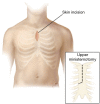Minimally invasive aortic valve surgery
- PMID: 33841981
- PMCID: PMC8024826
- DOI: 10.21037/jtd-20-1968
Minimally invasive aortic valve surgery
Abstract
Since their introduction, it has been demonstrated that minimally invasive aortic valve replacement (MIAVR) approaches are safe and effective for the treatment of aortic valve diseases. To date, the main advantage of these approaches is represented by the reduced surgical trauma, with a subsequent reduced complication rate and faster recovery. This makes such approaches an appealing choice also for frail patients [obese, aged, chronic obstructive pulmonary disease (COPD)]. The standardization of the minimally invasive techniques, together with the implementation of preoperative workup and anesthesiological intra- and post-operative care, led to an amelioration of surgical results and reduction of surgical times. Moreover, the improvement of surgical technology and the introduction of new devices such as sutureless and rapid deployment (SURD) valves, has helped the achievement of comparable results to traditional surgery. However, transcatheter technologies are nowadays more and more important in the treatment of aortic valve disease, also in low risk patients. For this reason surgeons should put new efforts for further reducing the surgical trauma in the future, even taking inspiration from other disciplines. In this review, we aim to present a review of literature evidences regarding minimally invasive treatment of aortic diseases, also reflecting our personal experience with MIAVR techniques. This review could represent a tool for a well-structured patient assessment and preoperative planning, in order to safely carrying out an MIAVR procedure with satisfactory outcomes.
Keywords: Minimally invasive; aortic valve surgery; minimally invasive cardiac surgery aortic valve replacement (MICS AVR); ministernotomy (MS); right anterior thoracotomy (RAT).
2021 Journal of Thoracic Disease. All rights reserved.
Conflict of interest statement
Conflicts of Interest: All authors have completed the ICMJE uniform disclosure form (available at http://dx.doi.org/10.21037/jtd-20-1968). The series “Minimally Invasive Cardiac Surgery” was commissioned by the editorial office without any funding or sponsorship. AM serves as an unpaid editorial board member of Journal of Thoracic Disease from Feb 2021 to Jan 2023. Dr. AM and Dr. MG report personal fees from LivaNova, outside the submitted work. The authors have no other conflicts of interest to declare.
Figures









Similar articles
-
Minimally invasive aortic valve surgery: state of the art and future directions.Ann Cardiothorac Surg. 2015 Jan;4(1):26-32. doi: 10.3978/j.issn.2225-319X.2015.01.01. Ann Cardiothorac Surg. 2015. PMID: 25694973 Free PMC article. Review.
-
Minimally invasive and conventional aortic valve replacement: a propensity score analysis.Ann Thorac Surg. 2013 Sep;96(3):837-43. doi: 10.1016/j.athoracsur.2013.04.102. Epub 2013 Jul 16. Ann Thorac Surg. 2013. PMID: 23866805
-
Sutureless implantation of the perceval s aortic valve prosthesis through right anterior minithoracotomy.Ann Thorac Surg. 2013 Dec;96(6):2101-8. doi: 10.1016/j.athoracsur.2013.07.007. Epub 2013 Sep 18. Ann Thorac Surg. 2013. PMID: 24054468
-
Current era minimally invasive aortic valve replacement: techniques and practice.J Thorac Cardiovasc Surg. 2014 Jan;147(1):6-14. doi: 10.1016/j.jtcvs.2013.08.086. Epub 2013 Nov 1. J Thorac Cardiovasc Surg. 2014. PMID: 24183904 Review.
-
Preoperative planning of left-sided valve surgery with 3D computed tomography reconstruction models: sternotomy or a minimally invasive approach?Interact Cardiovasc Thorac Surg. 2016 May;22(5):587-93. doi: 10.1093/icvts/ivv408. Epub 2016 Jan 29. Interact Cardiovasc Thorac Surg. 2016. PMID: 26826714 Free PMC article.
Cited by
-
Rationale and design for the thoracic Paravertebral Adjunctive Dexamethasone Palmitate Reducing chronic pain After cardiac surgery (PANDORA) trial: a parallel-group, double-blinded, randomised controlled, single-centre study.BMJ Open. 2025 Jan 15;15(1):e086392. doi: 10.1136/bmjopen-2024-086392. BMJ Open. 2025. PMID: 39819928 Free PMC article.
-
Minimally invasive surgical aortic valve replacement versus transfemoral transcatheter aortic valve implantation in low-risk octogenarians : Observational, retrospective and single-center study.Wien Klin Wochenschr. 2023 Dec;135(23-24):703-711. doi: 10.1007/s00508-022-02094-z. Epub 2022 Oct 14. Wien Klin Wochenschr. 2023. PMID: 36239806
-
Totally endoscopic aortic valve replacement: Techniques and early results.Front Cardiovasc Med. 2023 Jan 9;9:1106845. doi: 10.3389/fcvm.2022.1106845. eCollection 2022. Front Cardiovasc Med. 2023. PMID: 36698939 Free PMC article.
-
Gender-Tailored Heart Team Decision Making Equalizes Outcomes for Female Patients after Aortic Valve Replacement through Right Anterior Small Thoracotomy (RAST).J Cardiovasc Dev Dis. 2024 Oct 16;11(10):329. doi: 10.3390/jcdd11100329. J Cardiovasc Dev Dis. 2024. PMID: 39452299 Free PMC article.
-
A comparative study of minimally invasive aortic valve replacement with sutureless biological versus mechanical prostheses.Kardiochir Torakochirurgia Pol. 2023 Jun;20(2):77-82. doi: 10.5114/kitp.2023.129542. Epub 2023 Jul 26. Kardiochir Torakochirurgia Pol. 2023. PMID: 37564970 Free PMC article.
References
-
- STS National Database Spring 2003, Executive summary, Duke Clinical Research Institute, Durham, NC; 2003.
Publication types
LinkOut - more resources
Full Text Sources
Other Literature Sources
